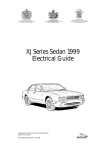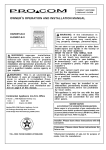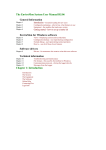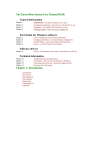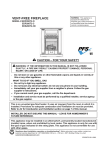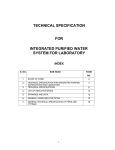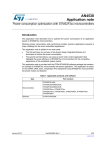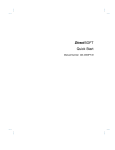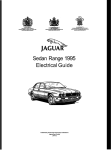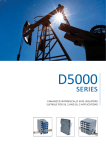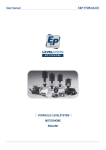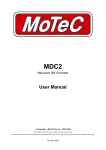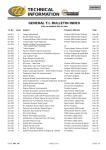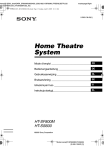Download Perkins Electrical TI Bulletin - Cape Dory Sailboat Owners Association
Transcript
TECHNICAL INFORMATION CONTENTS ELECTRICS T.I. BULLETIN INDEX Click on bulletin title to view Note: Some of the following bulletins, although containing electrical information, have already been issue in different sections. They are also listed here for convenience. Click on the bulletin title to transfer to the appropriate bulletin. T.I. No. Issue Subject Products Affected Date Gn 008 Gn 017 Gn 018 Gn 019 GX 006 GX 017 GX 022 GX 025 GX 034 GX 037 1 1 1 1 1 1 1 2 1 1 Alternator Connections on Mainframe Harness Perkins Engines as applicable Starter Motors All Perkins Engines Magneti Marelli Service/Warranty Support All Perkins Engines Service Department - Computer Diagnostic Equipment Solenoid Valve Coils - Diode Protection SS600, PS700, SS400 Elec. Op. Solenoid Valve Coils - Retaining Nuts & ‘O’ Rings All fitted with Solenoid Valves Powershift Trans. Electrical Changes All PS700 Introduction of Autoshift Transmission E.C.U. PS700 4 Speed Powershift Electrical Changes Powershift Introduction of Speed Sensor Tester Powershift with ECU/Speed Sen. Nov. 93 Mar. 96 Apr. 96 Nov. 97 Feb. 95 Nov. 96 Mar. 97 Nov. 98 Nov. 97 Feb. 98 EL001 EL002 EL003 EL004 EL005 EL006 EL007 EL008 EL009 EL010 1 1 1 1 1 1 1 1 1 1 ECU Diagnostics Electrical Harness Repair Components - IP67 Electrical Harness Repair Procedure - IP67 Replacement Transmission Solenoids Hobbs Gear Lever with Dedicated Neutral Line Powertrain Switches Overview of Powershift Trans. E.C.U. Hobbs Wiper/Turn Signal Column Switch Trans. Low Pressure Oil Light Illumination Alternator Suppressor Nov. 98 Dec. 98 Dec. 98 Sep. 98 Nov. 98 Nov. 98 Dec. 98 Oct. 98 Nov. 98 July 99 DATE: SEP '99 PAGE 1 OF 1 Powershift with 36 way ECU All All SS600 Syncro Shuttle All Powershift with Hobbs levers All Powertrains PS700 4 Speed Part Number 475/42300 SS600 and PS700 Perkins 1000 Series ISSUE: 2 SAFETY NOTICE - Instructions in the Service Bulletins assume that the engineer has a sound knowledge of safety procedures and has been trained in the maintenance and repair of ITL equipment. If you are unsure or do not understand information contained in the Service Bulletins then ask your supervisor or contact ITL SERVICE for advice. Remember SAFETY MUST COME FIRST. Number EL001 (JCB ref: Trans003) Issue Date ECU DIAGNOSTICS INSTRUCTIONS 1 Nov. 1998 Page 1 of 9 PRODUCTS AFFECTED: Powershift Transmissions with 36-Way ECU 1. INTRODUCTION: 1.1. Literature Notation Bold blue text refers to ITL products and part numbers. Bold green text refers to non-ITL products, brand-names and trademarks. & The open book symbol denotes notes, hints and tips which are useful to remember. The attention symbol outlines critical information which must be remembered or adhered to at all times. 1.2. Overview The PC Diagnostics software is supplied on the parts CD-ROM, or can be supplied on a separate floppy disk. The following instructions explain how to install the software onto your computer; how to use the software and how to remove it if necessary. This software is intended for use on IBM compatible Personal Computers running Windows 95 or later and is not compatible with earlier versions of Windows 3.x or Windows NT. The software is the property of International Transmissions Limited and is copy protected. The software may only be installed from the original disk. Attempting to copy the software between PCs with render the program un-usable. THIS BULLETIN IS ISSUED FOR THE PURPOSE OF CIRCULATING TECHNICAL INFORMATION AND DOES NOT CONSTITUTE AN INSTRUCTION TO CARRY OUT WARRANTY REPAIRS ON MACHINES. ISSUED BY THE TECHNICAL SERVICE DEPARTMENT OF I.T.L., WREXHAM, CLWYD, LL13 9UF, UNITED KINGDOM EL001 Page 2 of 9 2. Issue 1 INSTALLING THE SOFTWARE: 2.1. Place the original disk into the appropriate disk drive. 2.2. Select Run from the Start Menu. 2.3. For CD-ROM installation type; d:\Pc\Powershift ECU Diagnostics\setup.exe 2.4. For Floppy Disk installation type; a:\setup.exe or use the button to locate these files. 2.5. The setup program will then start Windows 95 InstallShield Wizard, displaying the following window; 2.6. The dark blue setup window will then appear, maximised to the full screen size. In this main setup window the following windows will be displayed. 2.7. The setup program welcomes the user and offers some helpful advice. Please follow the recommendations if any problems are encountered. ……continued EL001 Page 3 of 9 & At any point the user may click on; a). the 2.8. & 2.9. Issue 1 button to exit, b). the button to continue or, c). the button to go back to the previous window. Select the destination directory into which the application will be installed. It is recommended that the default directory is used, or click on the button to select another location. Select the program folder in which the application is added (this also creates the links to the application in the Start Menu) ……continued EL001 Page 4 of 9 & Issue 1 Again it is recommended that the default folder is used. 2.10. The setup program will then install the application onto the computer. 2.11. Wait while the program installs the files, updates the Windows 95 registry and adds the icons. 2.12. When the setup process is complete the dark blue window closes and the program folder window can be seen open on the desktop. At this point the installation of the Powershift ECU Diagnostics software is complete !!! 3. RUNNING THE SOFTWARE 3.1. The simplest method of starting the software is to locate the icon in the Start Menu as shown below 3.2. The title will appear indicating that the application is loading. 3.3. ……continued If the ECU is not connected and powered-up then the application loads as shown below; Page 5 of 9 3.4. & EL001 Issue 1 Connect the 9-pin D-type connector of the communications lead into the serial port of the PC. Do not worry if more than one serial port (COM port, e.g. COM1, COM2 etc.. ) is present as then software will automatically detect which port is connected to the ECU. 3.5. Connect the other end of the communications lead into the ECU diagnostics connector provided on the machine. 3.6. Turn on the power to the ECU (e.g. turn the key-switch to the ignition position). 3.7. The ECU can then be interrogated by clicking on 3.8. The window will then display the real-time status of the ECU, and example is shown below; 3.9. the button. ……continued The example above shows the ECU settings and status for a 4 speed manually operated ECU. (i.e. 4 gears which can be engaged independently by the operator) EL001 Page 6 of 9 Issue 1 3.10. Please read the appropriate machine or gearbox service manual for full details of how to use this software to diagnose electrical faults on the transmission. 3.11. Should there be a problem with the communications then the following error message will appear. 3.12. The ECU can detect if there is a problem with the gearbox solenoids or the associated interconnections. On ‘Scanning’ the ECU, if such an error is detected them the following error message will appear. 3.13. The faulty solenoid / connection can pinpointed within the software as explained in the next section. 3.14. If the above warning is displayed, or to look at the Solenoid Status at any time then click on the button. The Unit Status section (bottom right corner) of the window, showing the status of the ECU inputs and present gear selection, will freeze whilst doing this operation. The left half of the window will also ‘grey-out’. 3.15. Faulty solenoids or connections will be shown highlighted. In the example below we can see that all the solenoids are faulty. (This would mean that the gearbox harness is not connected.) ……continued 3.16. The solenoid name will be seen to become un-highlighted as the fault is cured 3.17. Click on window. the button to exit this feature and to unfreeze the rest of the EL001 Page 7 of 9 4. Issue 1 REMOVING THE SOFTWARE 4.1. Start up the control panel from the Start Menu. 4.2. Double-click on the Add/Remove Programs icon. 4.3. ……continued From the Add/Remove Programs Properties window select the Powershift ECU Diagnostics item and click on the button. Page 8 of 9 EL001 Issue 1 4.4. Confirm that the application is to be removed by clicking on the button. 4.5. The Windows 95 InstallShield (used to install the application) will then remove the software completely. ……continued 4.6. All icons, shortcuts and folders will be removed automatically by Windows 95. Page 9 of 9 5. EL001 Issue 1 ADDITIONAL INFORMATION This software does not support diagnostics of the earlier range of ITL Powershift Controllers in the 18Way housing. To diagnose faults on machine electrical systems fitted with the 18-Way ECUs a dedicated Handheld Test Unit (MkII) is available (Part No. 892/00943). This Test Unit is supplied with its own handbook (Publication No. 9801/0166) which includes operating instructions, fault finding guide and tips on common faults. The Powershift ECU Diagnostics software complements the range of diagnostics software available for the PSION Workabout, the standard ITL diagnostics tool. For further details on the diagnostics software for the PSION Workabout please read the relevant literature on the ITL CD-ROM. INDEX TECHNICAL INFORMATION ! SAFETY NOTICE - Instructions in the Service Bulletins assume that the engineer has a sound knowledge of safety procedures and has been trained in the maintenance and repair of ITL equipment. If you are unsure or do not understand information contained in the Service Bulletins then ask your supervisor for advice. Remember SAFETY MUST COME FIRST. Electrics Number EL002 (JCB 2/174; C45/N.Am.) Issue Date SUBJECT: Electrical Harness Repair Components - IP67 Standards PRODUCTS AFFECTED: All TO BE CARRIED OUT: For Information Only 1 Dec. 1998 Page 1 of 2 SERVICE INFORMATION: Instances do occur where it is necessary to incorporate auxiliary electrical components into existing electrical circuits and repair or replace specific individual wires or connectors. This bulletin introduces part numbers for various electrical connectors and terminals used in JCB IP67 wiring harnesses. The bulletin should also be read in conjunction with Electrical Bulletin EL003. ! CAUTION: When installing Auxiliary Electrical Components always ensure that the additional load rating is suitable for that particular circuit. It is not recommended to increase the fuse rating as this can cause overloading and consequential failure of wiring, along with failure of integral circuit components, which the fuse is protecting. Packard Connector Sumitumo Connector Econoseal Connector 270470 270480 270490 Splices Hirschmann Connector 270500 270510 ITT Canon Connector 270520 FLYING LEADS AMP (Relay Term.) Pozilock AMP Jnr. Connector Relay & Base 270540 270530 270550 Pressac Fuse Blade THIS BULLETIN IS ISSUED FOR THE PURPOSE OF CIRCULATING TECHNICAL INFORMATION AND DOES NOT CONSTITUTE AN INSTRUCTION TO CARRY OUT WARRANTY REPAIRS ON MACHINES ISSUED BY THE TECHNICAL SERVICE DEPARTMENT OF I.T.L., WREXHAM, CLWYD, LL13 9UF, UNITED KINGDOM Page 2 of 2 PART No DESCRIPTION EL002 TYPE PART No Issue 1 DESCRIPTION TYPE 7201/0008 FUSE BOX TERMINAL 0.5 - 1.25mm PR. 7219/0002 10 WAY PIN HOUSING SUM. 7201/0009 FUSE BOX TERMINAL 1.0 - 3.2mm PR. 7219/0003 10 WAY PIN RETAINER SUM. 7201/0010 FUSE BOX TERMINAL 2.5 - 6.0mm PR. 7219/0004 10 WAY RECEPTICAL RETAINER SUM. 7201/0427 RELAY BASE TERMINAL 0.5 - 1.0mm AMP 7219/0005 14 WAY RECEPTICAL HOUSING SUM. 7201/0428 RELAY BASE TERMINAL 4.0 - 6.0mm AMP 7219/0006 14 WAY PIN HOUSING SUM. 7201/0429 RELAY BASE TERMINAL 1.3 - 3.4mm AMP 7219/0007 14 WAY PIN RETAINER SUM. 7210/0001 DUMMY PLUG SUM. 7219/0008 14 WAY RECEPTICAL RETAINER SUM. 7210/0008 DUMMY PLUG PACK. 7220/0001 31 WAY RECEPTICAL BULKHEAD HOUSING ITT 7210/0015 DUMMY PLUG ECON. 7220/0002 31 WAY PIN HOUSING ITT 7210/0017 DUMMY PLUG AMP 7220/0003 31 WAY PIN BULKHEAD HOUSING ITT 7211/0001 1 WAY PIN HOUSING PACK. 7220/0004 31 WAY RECEPTICAL HOUSING ITT 7211/0002 1 WAY RECEPTICAL HOUSING PACK. 7220/0005 4 WAY PIN BULKHEAD HOUSING ITT 7212/0001 2 WAY RECEPTICAL HOUSING SUM. 7220/0006 4 WAY RECEPTICAL HOUSING ITT 7212/0002 2 WAY PIN HOUSING SUM. 7220/0007 32 WAY RECEPTICAL HOUSING ITT 7212/0003 2 WAY PIN RETAINER SUM. 7220/0008 32 WAY PIN BULKHEAD HOUSING ITT 7212/0004 2 WAY RECEPTICAL RETAINER SUM. 7220/0009 19 WAY PIN BULKHEAD HOUSING ITT 7212/0005 2 WAY RECEPTICAL HOUSING PACK. 7220/0010 19 WAY RECEPTICAL HOUSING ITT 7212/0006 2 WAY PIN HOUSING PACK. 7220/0012 48 WAY RECEPTICAL HOUSING ITT 7212/0008 2 WAY RECEPTICAL HOUSING ECON. 7220/0013 48 WAY PIN BULKHEAD HOUSING ITT 7212/0009 2 WAY RECEPTICAL RETAINER ECON. 7220/0014 18 WAY ECONOSEAL RECEPTICAL RETAINER ECON. 7212/0014 2 WAY METRIPACK RECEPTICAL HOUSING PACK. 7220/0015 18 WAY ECONOSEAL RECEPTICAL HOUSING ECON. 7212/0015 3 WAY METRIPACK RECEPTICAL RETAINER PACK. 7220/0016 36 WAY ECONOSEAL RECEPTICAL RETAINER ECON. 7212/0020 2 WAY J/TIMER RECEPTICAL HOUSING AMP 7220/0017 36 WAY ECONOSEAL RECEPTICAL HOUSING ECON. 7212/0021 2 WAY J/TIMER HOUSING AMP 7231/0001 SINGLE RELAY BASE SLOT-IN-TYPE RELAY 7213/0001 3 WAY RECEPTICAL HOUSING SUM. 7232/0002 SWITCH LIGHT BULB HOLDER SWF 7213/0002 3 WAY PIN HOUSING SUM. 7233/0010 HIRSCHMANN PLUG SEAL HIRSCH. 7213/0003 3 WAY PIN RETAINER SUM. 7234/0003 IGNITION SWITCH PLUG (1) MERIT 7213/0004 3 WAY RECEPTICAL RETAINER SUM. 7236/0003 IGNITION SWITCH PLUG (2) MERIT 7213/0005 3 WAY RECEPTICAL HOUSING (DT) SUM. 7238/0001 8 WAY SWITCH BASE PLUG SWF 7213/0006 3 WAY PIN HOUSING (DT) SUM. 892/00350 BUTANE HEATER ASSEMBLY 7213/0007 3 WAY PIN RETAINER (DT) SUM. 892/00351 SPLICE 0.5 - 1.5mm - RED 7213/0008 3 WAY RECEPTICAL RETAINER (DT) SUM. 892/00352 SPLICE 1.5 - 2.5mm - BLUE 7213/0009 3 WAY RECEPTICAL HOUSING PACK. 892/00353 SPLICE 3 - 6mm - YELLOW 7213/0010 3 WAY PIN HOUSING PACK. 892/00869 PIN / RECEPTICAL REMOVAL TOOL (POWER) ITT 7214/0001 4 WAY RECEPTICAL HOUSING SUM. 892/00870 PIN / RECEPTICAL REMOVAL TOOL (SIGNAL) ITT 7214/0002 4 WAY PIN HOUSING SUM. 993/56700 FLYING LEAD SUMITOMO 1mm SUM. 7214/0003 4 WAY PIN RETAINER SUM. 993/56800 FLYING LEAD SUMITOMO 2mm SUM. 7214/0004 4 WAY RECEPTICAL RETAINER SUM. 993/56900 FLYING LEAD PACKARD 1mm PACK. 7214/0005 4 WAY RECEPTICAL HOUSING (INLINE) PACK. 993/57000 FLYING LEAD PACKARD 2mm PACK. 7214/0006 4 WAY PIN HOUSING (INLINE) PACK. 993/57100 FLYING LEAD 90DEGREE POZILOCK 1mm POZI. 7214/0007 4 WAY PIN HOUSING (BLOCK) PACK. 993/57200 FLYING LEAD 90DEGREE POZILOCK 2mm POZI. 7214/0008 4 WAY RECEPTICAL HOUSING (BLOCK) PACK. 993/57300 FLYING LEAD 2mm RELAY 7214/0009 4 WAY ECONOSEAL PIN HOUSING ECON. 993/57400 FLYING LEAD 3mm RELAY 7214/0010 4 WAY ECONOSEAL RECEPTICAL HOUSING ECON. 993/57500 FLYING LEAD POZILOCK & FUSE BLADE 2mm POZI. 7214/0011 4 WAY ECONOSEAL PIN RETAINER ECON. 993/57600 FLYING LEAD POZILOCK & FUSE BLADE 3mm POZI. 7214/0012 4 WAY ECONOSEAL RECEPTICAL RETAINER ECON. 993/57700 FLYING LEAD POZILOCK & FUSE BLADE 4mm POZI. 7216/0001 6 WAY RECEPTICAL HOUSING SUM. 993/57800 FLYING LEAD 1mm RELAY 7216/0002 6 WAY PIN HOUSING SUM. 993/57900 FLYING LEAD ITT CANON 1mm (SIGNAL) ITT 7216/0003 6 WAY PIN RETAINER SUM. 993/58000 FLYING LEAD ITT CANON 1.5mm (SIGNAL) ITT 7216/0004 6 WAY RECEPTICAL RETAINER SUM. 993/58100 FLYING LEAD ITT CANON 2mm (SIGNAL) ITT 7216/0005 6 WAY RECEPTICAL HOUSING PACK. 993/58200 FLYING LEAD ITT CANON 3mm ( POWER) ITT 7216/0006 6 WAY PIN HOUSING PACK. 993/58300 FLYING LEAD ITT CANON 4mm (POWER) ITT 7216/0007 6 WAY ECONOSEAL RECEPTICAL HOUSING ECON. 993/58400 FLYING LEAD AMP J/TIMER 1mm AMP 7216/0008 6 WAY ECONOSEAL RECEPTICAL RETAINER ECON. 993/58500 FLYING LEAD AMP J/TIMER 2mm AMP 7216/0009 6 WAY ECONOSEAL PIN HOUSING ECON. 993/58600 FLYING LEAD AMP POZLK & FUSE BLADES 1mm POZI. 7216/0010 6 WAY ECONOSEAL PIN RETAINER ECON. 993/69600 AMP. JUNIOR TIMER 2mm AMP 7216/0011 6 WAY ECONOSEAL PANEL MOUNT PIN HSG. ECON. 998/00001 FLYING LEAD ECONOSEAL 1mm ECON. 7218/0001 8 WAY RECEPTICAL HOUSING SUM. 998/00002 FLYING LEAD ECONOSEAL 1.5mm ECON. 7218/0002 8 WAY PIN HOUSING SUM. 7218/0003 8 WAY PIN RETAINER SUM. PR = Pressac; SUM. = Sumitumo; Pack. = Packard; Econ. = Econoseal; 7218/0004 8 WAY RECEPTICAL RETAINER SUM. Pozi. = Pozilock; 7219/0001 10 WAY RECEPTICAL HOUSING SUM. INDEX TECHNICAL INFORMATION ! SAFETY NOTICE - Instructions in the Service Bulletins assume that the engineer has a sound knowledge of safety procedures and has been trained in the maintenance and repair of ITL equipment. If you are unsure or do not understand information contained in the Service Bulletins then ask your supervisor for advice. Remember SAFETY MUST COME FIRST. SUBJECT: Electrical Harness Repair Procedure - IP67 Standards PRODUCTS AFFECTED: All TO BE CARRIED OUT: For Information Only Electrics Number EL003 (JCB Gen 021) Issue Date 1 Dec. 1998 Page 1 of 3 SERVICE INFORMATION: Instances do occur where it is necessary to incorporate auxiliary electrical components into existing electrical circuits and repair or replace specific individual wires within a harness. To ensure that either the inclusion of an auxiliary electrical component or a repair within a harness is actioned to an acceptable standard it is strongly recommended that the following tools, equipment and procedures are always used to ensure the installation is maintained to IP.67 standards. The sheath covering of the recommended splice is heat shrunk onto the original wire insulation. This results in a seal and corresponding joint to IP 67 specifications. ! CAUTION: When installing Auxiliary Electrical Components always ensure that the additional load rating is suitable for that particular circuit. It is not recommended to increase the fuse rating as this can cause overloading and consequential failure of wiring, along with failure of integral circuit components, which the fuse is protecting. ! WARNING:In addition to the warnings incorporated into the procedure, extreme care should be taken when handling the gas heating tool to ensure that the flame does not damage or set fire to any items in the vicinity of the repair, i.e. other wires, floor panels, floor mats, sound proofing, paintwork. etc. This tool should not be used in any restricted location prohibiting the use of "Naked Flames' or where risk of explosive gas or similar safety parameters apply. No other heat source should be used to attempt a sealed joint . TOOLS REQUIRED: 892/00350 892/00349 892/00351 892/00352 892/00353 Butane Heater assembly Crimp tool Splice 0.5-1.5 mm (Red) Splice 1.5-2.5 mm (Blue) Splice 3.0-6.0 mm (Yellow) 1 1 50 50 50 THIS BULLETIN IS ISSUED FOR THE PURPOSE OF CIRCULATING TECHNICAL INFORMATION AND DOES NOT CONSTITUTE AN INSTRUCTION TO CARRY OUT WARRANTY REPAIRS ON MACHINES ISSUED BY THE TECHNICAL SERVICE DEPARTMENT OF I.T.L., WREXHAM, CLWYD, LL13 9UF, UNITED KINGDOM Page 2 of 3 EL003 Issue 1 PROCEDURE: 1 Cut the wire and remove the protective insulation for a suitable distance dependent upon the size of wire and splice to be used. For the splices detailed on page 1, the dimension is 7mm. 2 Using the correct sized splice, attach the new section of wire required or auxiliary flying lead to the existing harness and secure using the crimp tool X, part number 892/00349. Note that each of the splices detailed is colour-coded to make size and range readily visible. They are secured using the corresponding size and matching colour-coded jaws of the crimp tool to ensure joint security. This tool also incorporates a ratchet closing mechanism which will not release until the splice is fully closed to the correct compression size. 3 With the Butane heater assembly, 892/00350, seal the connection using the procedure on the next page. 7 X 189530 Page 3 of 3 EL003 Issue 1 C A F E D B S189490/1 With the Butane Heater assembly 892/00350, seal the connection using the following procedure. 3.1 Remove the cap A from the end of the disposable gas cartridge B. S189490/2 3.2 Before assembling the gas cartridge to the reflector element C, turn the red ring D to the left, (in the direction of the minus sign marked on the ring). S189490/3 3.3 Position the tube hanging down from inside the reflector assembly into the hole at the top of the gas cartridge. Then press the gas cartridge up into the reflector assembly as far as possible until the two elements are clasped firmly together. A click will be heard. S189490/4 3.4 Turn the small ring E so that the air holes at F are completely closed. G G F E D S189490/5 3.5 Turn the red ring D to the right (in the direction of the plus sign) in order to turn on the gas. IMPORTANT: Before turning the heater on, make sure that the cartridge is not hotter than the reflector element. This may occur if the cartridge is held in the hand for a long time. The temperature difference between the cartridge and the reflector element may cause long yellow flames to appear on ignition. S189490/6 3.6 Hold the heater vertically and, using a match or cigarette lighter, light the gas as shown. Note: The fact that the sound of liquid cannot be heard when the cartridge is shaken does not mean it is empty. No sound will be heard even when the cartridge is full. Hold the heater vertically for 1 to 2 minutes until the catalytic reaction occurs. This is indicated when the blue flame fades and the ceramic element glows red. Then turn the small ring E until the air holes at F are completely open. The tool is ready for use. S189490/7 The heater can be used in two modes: 3.7 Side wings G down, reflector head completely open. In this mode the infra red heat waves are dominant (recommended for the light coloured plastic splices). S189490/8 3.8 Side wings G up, reflector head opening reduced. In this mode the heating is done only by the hot gas (use for dark coloured plastic splices). To switch off the heater, turn the red ring D to the left (in the direction of the minus sign). ! CAUTION When the heater is in use, the reflector and the air coming out are extremely hot. Keep away to avoid accidental burns. Do not touch the reflector until it has had time to cool down after switching off. If flame reappears at the reflector when the heater is in use, the catalytic element is damaged or used up. Stop work immediately and replace the heater. INDEX TECHNICAL INFORMATION ! SAFETY NOTICE - Instructions in the Service Bulletins assume that the engineer has a sound knowledge of safety procedures and has been trained in the maintenance and repair of ITL equipment. If you are unsure or do not understand information contained in the Service Bulletins then ask your supervisor for advice. Remember SAFETY MUST COME FIRST. Electrics Number EL004 (JCB Gen 085; C65/N. Am.) Issue Date 1 Sep. 1998 SUBJECT: Replacement Transmission Solenoids Page 1 of 1 PRODUCTS AFFECTED: Forward and Reverse Solenoids Fitted To ITL SS600 Syncro Shuttle Transmissions TO BE CARRIED OUT: For Information Only SERVICE INFORMATION: Replacement transmission solenoids with connectors type A have been superseded to the current connector type B. To change this type of connector the machine harness will have to be modified by splicing on a new connector C. Refer to JCB T.I. 2/174 (C45 N. Am.) March 1997 and JCB General Bulletin 020 (C30 N. Am.) Feb. 93. Solenoids with connectors type D have also been superseded to the current type connector type B. To enable this type of connecter to be used, link harness E is available for service use. SERVICE PROCEDURE: IMPORTANT NOTE: All later solenoids have diodes built into the coils. The diodes will be damaged if the coil is connected with reverse polarity causing the coil to fail and the fuse to blow. Identify the positive wire on the machine, note the solenoid coil is marked positive and negative, connect the wires into the new connector the correct way round as shown at F. Ensure the wire seals G are fitted to the plug to prevent water ingress. F PARTS INFORMATION Item C E Part Number 993/69600 718/44900 Description Connector Link Harness B A D C THIS BULLETIN IS ISSUED FOR THE PURPOSE OF CIRCULATING TECHNICAL INFORMATION AND DOES NOT CONSTITUTE AN INSTRUCTION TO CARRY OUT WARRANTY REPAIRS ON MACHINES ISSUED BY THE TECHNICAL SERVICE DEPARTMENT OF I.T.L., WREXHAM, CLWYD, LL13 9UF, UNITED KINGDOM INDEX TECHNICAL INFORMATION ! SAFETY NOTICE - Instructions in the Service Bulletins assume that the engineer has a sound knowledge of safety procedures and has been trained in the maintenance and repair of ITL equipment. If you are unsure or do not understand information contained in the Service Bulletins then ask your supervisor for advice. Remember SAFETY MUST COME FIRST. Electrics Number EL005 Issue Date 1 Nov. 1998 SUBJECT: Introduction of Hobbs Gear Lever with Dedicated Neutral Line Page 1 of 2 PRODUCTS AFFECTED: All Powershift Transmissions with Hobbs ITL supplied forward and reverse levers TO BE CARRIED OUT: Information only SERVICE INFORMATION: A new Powershift forward, reverse and speed change lever, lTL part number 475/51090, was introduced from July 1998 in order to simplify OEM wiring. The new lever has a different 12 pin Deutsch wiring connection and provides a dedicated neutral circuit feed. The previous lever 475/42100 with 8 pin connection will remain available for service use. ln order to fit the new lever in place of the old lever the machine wiring must be modified by adding an additional explicit neutral feed to the transmission ECU and changing the harness plug. Additional Information 1 ITL notification of change 0705 applies. 2 - Wiring connection (and the lever) should be protected from pressure washing or hot water/steam cleaning particularly if washing chemicals are used. - A suitable shroud around the wiring connections on non cabbed machines is recommended to protect the wiring connection from direct water jets. Parts Information Description Gear Lever Part Number 475/51090 cont’d THIS BULLETIN IS ISSUED FOR THE PURPOSE OF CIRCULATING TECHNICAL INFORMATION AND DOES NOT CONSTITUTE AN INSTRUCTION TO CARRY OUT WARRANTY REPAIRS ON MACHINES ISSUED BY THE TECHNICAL SERVICE DEPARTMENT OF I.T.L., WREXHAM, CLWYD, LL13 9UF, UNITED KINGDOM Page 2 of 2 EL005 The illustrations show both a gear switch A and a multifunction switch B. Item A incorporates a locating pin X which engages with a drilled hole in the column to ensure correct location and prevents rotation of the switch mounting. The two switches are clamped onto the shaft using two screws D. If item B is not required, mounting clamp C should be used instead. Issue 1 A C The gear switch incorporates a rotary selector for gears 1, 2, 3, 4 and a horn button (or kickdown button). Forward/Reverse selection is made by lifting the lever out of its neutral (detent) position and moving it forward (for forward direction) or back (for reverse direction). D X B Note: An explicit neutral line is incorporated to simplify the neutral start circuit (i.e. no additional relays are required to decode neutral). Gear Switch Connections Y 9 10 11 12 1 1 8 2 2 7 3 3 9 10 11 12 4 4 8 5 2 6 R 5 Z Y 6 7 1st gear 2nd gear 3rd gear 4th gear Horn (or kickdown) load Reverse Forward Neutral Feed 6 1 2 3 4 6 7 9 11 12 7 7 8 N 11 12 1 9 2 3 3 1 1 4 5 2 4 10 11 3 9 4 A302480 A302480 12.5 ø6 R N Deutsch Mating Connector Requirements Item 6 F Multi-function Switch Connections Z 1 Flasher mode 2 Washer feed 3 High beam 4 Headlamp feed 5 Low beam 6 Wiper park 7 Wash/Wipe load 8 Wiper feed 9 Left turn 10 Right turn 11 Turn signal feed Deutsch Part No. ITL Part No. Qty. Y E F ø45 12.5 Housing (12 way) Terminal Socket Contact (female) Locking Wedge Seal Plug DT06-12S 1062-16--0122 0462-201-16141 W12S 114017 460/34901 1 460/34702 460/34902 460/34903 1 6 ø45 E A302280 Connectors E must be protected by a suitable cover against damage and high pressure washes. INDEX TECHNICAL INFORMATION ! SAFETY NOTICE - Instructions in the Service Bulletins assume that the engineer has a sound knowledge of safety procedures and has been trained in the maintenance and repair of ITL equipment. If you are unsure or do not understand information contained in the Service Bulletins then ask your supervisor for advice. Remember SAFETY MUST COME FIRST. SUBJECT: Powertrain Switches PRODUCTS AFFECTED: All Powertrains TO BE CARRIED OUT: For Information only Electrics Number EL006 Issue Date 1 Nov. 1998 Page 1 of 2 SERVICE INFORMATION: This Technical bulletin is issued to answer typical service questions relating to Powertrain switches supplied to OEMs by ITL. Note: Some OEMs use their own switches. 1 The table on page 2 indicates the switch description, thread, locations, part number and operating values. Contact ITL Technical Sales if further details are required. 2 The most common reason for switch failure is water ingress into the switch through the terminals because of defective or incorrect harness connections. ITL now supplies certain switches loose rather than fitted to the powertrain to help prevent water ingress during storage or shipping. Always protect switches during pressure washing especially if cleaning chemicals or steam (hot) pressure washes are used. Later ITL switches (from mid ‘97) have an Epoxy resin sealer added to help protect switches against defective wire seals. 4 Adaptor item ‘H’ 997/22100 can be used in conjunction with switch item ‘D’ 701/41600 for converting older pre ‘95 transmissions with the test point and previous type pressure switch (with “spade connections” on a separate ‘T’ piece) to the current switch. An ‘AMP junior timer’ link harness item ‘J’ 993/69600 is available for modifying machine harnesses. 5 ‘AMP junior timer’ switch harness connections are available from ITL for OEMs who are unable to source from AMP. Note: ITL can provide 2-Way “AMP Junior Timer” plug kits complete with housing, terminals and wire seals (460/34600). THIS BULLETIN IS ISSUED FOR THE PURPOSE OF CIRCULATING TECHNICAL INFORMATION AND DOES NOT CONSTITUTE AN INSTRUCTION TO CARRY OUT WARRANTY REPAIRS ON MACHINES ISSUED BY THE TECHNICAL SERVICE DEPARTMENT OF I.T.L., WREXHAM, CLWYD, LL13 9UF, UNITED KINGDOM Page 2 of 2 EL006 Issue 1 Sensor Switch Positions A B C D S302210 Sensor switch A for transmission oil temperature is fitted in transmission oil cooler. E Sensor switch G for vacuum detection is fitted in the engine air cleaner. F H A301870 J G A310200 Part No. Colour Thread Size Function Operating Value Sealing Washer Part No. A 701/71300 Green 5/8” UNF Trans Oil Temperature Switch 110 °C ±5 1406/0014 B 701/37400 Yellow 5/8” UNF Engine Water Temperature Switch 102 °C ±5 1406/0014 C 716/12800 Red NPTF Engine Water Temperature Sender - Seal with PTFE Tape D 701/41600 Red Trans Oil Pressure Switch SS600 40PSI 1406/0011 E 701/43700 Grey BSP Trans Oil Pressure Switch PS700 40PSI 1406/0015 F 701/41500 Tan 1/8” NPTF Engine Oil Pressure Switch 30 - 50 PSI Seal with PTFE Tape G 701/36500 Black 1/8” NPTF Vacuum Sensor Switch 55 mbar Seal with PTFE Tape H 997/22100 N/A M10 x 1 x M12 x 1 Tee Adapter N/A Seal with PTFE Tape J 993/69600 N/A AMP Junior Timer Link Harness N/A N/A 1/2” M12 x 1mm 3/8” 1/4” BSP N/A INDEX TECHNICAL INFORMATION ! SAFETY NOTICE - Instructions in the Service Bulletins assume that the engineer has a sound knowledge of safety procedures and has been trained in the maintenance and repair of ITL equipment. If you are unsure or do not understand information contained in the Service Bulletins then ask your supervisor for advice. Remember SAFETY MUST COME FIRST. Electrics Number EL007 Issue Date 1 Dec. 1998 OVERVIEW OF POWERSHIFT TRANSMISSION ECU (460/378xx) Page 1 of 4 PRODUCTS AFFECTED: PS700 4 Speed Transmissions INTRODUCTION: The driveline comprises a Powershift transmission controlled by an Electronic Control Unit (E.C.U.). This provides the operator with manual selection of gears with added protection for both operator and transmission. In addition, a kickdown function is incorporated allowing the operator to temporarily select a lower gear if conditions demand. 2) KEY COMPONENTS: Transmission: The existing 4 speed Powershift transmission has a speed sensor fitted to detect the speed of rotation of the output shaft. This information provides road speed information to the E.C.U. (see below). E.C.U.: The 18/36 way type E.C.U. is a new component which replaces older 18/18 way type E.C.U’s (460/315xx). It is a Solid State, microprocessor-based, electronics "black box". Based upon data supplied from the column switch, kickdown button, (see Controls/ Instrumentation below), parkbrake switch, transmission dump switch and the speed sensor, the E.C.U. controls the gear selection solenoid valves on the transmission. 18-Way Connector 000/00000 1) 36-Way Connector Controls/Instrumentation: The column switch is the same as non E.C.U. transmissions (475/51090). The gears are selected on the Forward, Neutral, Reverse (FNR) lever rotary switch, positions "1", "2", “3” and "4" manually selecting those gears as machine conditions allow. An optional kickdown button can be fitted by the OEM (e.g. button on loader lever). If the kickdown is pressed, the next lowest gear is selected. By pressing kickdown again, the transmission will revert to the previous higher gear. Selecting reverse or another gear will also cancel the kickdown. An optional input for connection to the parkbrake warning light switch is available. This places the transmission in neutral whenever the parkbrake is operated, regardless of any other requested condition. If the operator tries to select forward or reverse direction whilst the parkbrake is still applied then the E.C.U. will sound a continuous tone on the warning buzzer whilst still holding the transmission in neutral. This feature improves parkbrake life as in lower gears the transmission can easily drive with the parkbrake engaged. ...... continued THIS BULLETIN IS ISSUED FOR THE PURPOSE OF CIRCULATING TECHNICAL INFORMATION AND DOES NOT CONSTITUTE AN INSTRUCTION TO CARRY OUT WARRANTY REPAIRS ON MACHINES ISSUED BY THE TECHNICAL SERVICE DEPARTMENT OF I.T.L., WREXHAM, CLWYD, LL13 9UF, UNITED KINGDOM Page 2 of 4 EL007 Issue 1 An optional input for a Four Wheel Drive (4WD) command signal is provided so that the operator may manually select 4WD. Note that 4WD will automatically disengage in 3rd and 4th gears to prevent drive line ‘wind-up’. Further control of the 4WD facility can be had by connecting the ‘Footbrake’ input to the tail light brake switch. Thus 4WD will be engaged whenever the operator uses the foot operated brakes. This feature operates in all gears, providing Four Wheel Braking (4WB). The warning buzzer and red warning light on the instrument panel will be activated if a gear selection is made which is not allowed by the E.C.U. software (see System logic). This comprises a double-bleep which will continue either until the selection conditions are met, or the request is de-selected. For a non-allowed kickdown request, the buzzer will double-bleep only once at the time of the request. 3) SYSTEM LOGIC The E.C.U. will not allow gear changes to occur if outside the pre-programmed conditions. The following description explains the system logic. Gearshifting: • 1st, 2nd, 3rd and 4th gears are selected in the normal way on the column switch, upshifts are engaged immediately on request. • The E.C.U. does not allow downshifts above certain speeds. If attempted, a double-bleep will sound and the transmission remains in its current gear until the speed has reduced sufficiently to allow a downshift to occur. Upshifting is not speed limited. • A change in direction can be made as long as the machine speed is below a specifically assigned value. • If 4WD is selected for the machine, 4WD is disengaged in 4th gear. Kickdown facility - Manual mode • Pressing the kickdown button will result in a gear change to the next lowest gear. • Kickdown operation is subject to the same pre-programmed speed limits as downshifts. If a non-allowed kickdown is requested, kickdown will not occur. The buzzer will sound a double-bleep. Note that the E.C.U. does not retain the kickdown request in its memory, so kickdown will have to be re-selected once the machine speed has reduced. • The transmission will revert to the original gear either by selecting a directional or gear change on the FNR lever or by pressing the kickdown button again, or when the pre-programmed time delay expires (default = 6 seconds). Note: Care is to be taken when downshifting, either by kickdown or manual selection on the column switch. It is recommended that downshifting is not requested at high speed, relying on the downshift protection system to avoid sudden deceleration. The downshift protection system is to reduce loads on the transmission, thereby improving its life, and is not to be used as a means of pre-selecting a downshift when slowing down. If the speed sensor fails, (see "Get you home" facility, next page), downshift protection will not be available. ECU Power-up operation: • A single double-beep is sounded to indicate the E.C.U. has been powered-up. Note: On machine power-up this indication may be overshadowed by other alarm sounds. However this doublebeep can be a useful aid to diagnosing intermittent E.C.U. power loss. • If the machine is stationary then the E.C.U. holds the transmission in neutral until the FNR lever is placed in or passed through the neutral position. • If the machine is moving when the E.C.U. is powered-up then the E.C.U. will select the appropriate gear for the given road speed. Warning buzzer/light: • A double-bleep will sound for the following reasons; Kickdown or manual downshift selected when machine speed is above the pre-programmed limit. Single double-beep on power-up (or on resumption of power supply). ......continued Page 3 of 4 3) EL007 Issue 1 SYSTEM LOGIC (continued) "Get you home" facility: • If the speed sensor fails, the buzzer will not sound. All gears will be available with kickdown but there will be no downshift speed protection. Care is to be taken when downshifting with either kickdown or gear selection on the column switch. On restarting the machine, 4th gear will be disabled to indicate to the operator that a fault has occurred and to limit the maximum speed. Diagnostics facility: • A 6-way AMP Econoseal connector must be provided by the OEM to allow connection by the service engineer to the on-board E.C.U. fault diagnostics system. • Service Edition Diagnostics software available for use with Psion Handheld Computer (ITL Standard Diagnostics Tool) or Personal Computer running Windows 95 (operating instructions are available for both formats). This software is intended for non-intrusive Diagnostics by OEM and/or approved agent(s). • A communications lead is available from ITL, part number 892/00952. Machine performance: • The overall machine performance is unchanged by the Powershift E.C.U. feature. All other features of the transmission will be as the current products without E.C.U. IMPORTANT - Non ITL standard Powershift E.C.U. features. This T.I. details the standard Powershift E.C.U. only. Note that the OEM may request different features from the standard Powershift E.C.U., for example, inhibiting 4th gear (as different country legislation requires). The OEM must ensure: • The OEM operator handbook details all features, including relevant non-standard E.C.U. features and logic. • The OEM service information details E.C.U. differences from the ITL manual. • All changes to the original E.C.U. settings or features supplied by ITL are approved in writing, including completion of the ITL E.C.U. engineering sign off document and the OEM’s own F.M.E.A. analysis carried out. • The OEM service network and all OEM customers are informed accordingly of the correct operating and service procedures, including SAFETY risk assessment. If you do not fully understand how the E.C.U. functions read the relevant ITL service manual and technical information, or contact ITL, before operating the machine or carrying out service work. E.C.U. Re-programming It is possible to tailor an existing production E.C.U. to refine the control of the transmission. The OEM may consider making changes to the E.C.U. at the prototyping or pre-production stages of a machines’ development if the OEM feels that this would be significantly beneficial to machine operation. It is recommended that changes are not made to E.C.U’s fitted to production machines. (However this flexibility is useful if a critical error between E.C.U. and application compatibility is discovered after a machine has been production released or the machine is in a special application, e.g. speed limiting required.) IMPORTANT - It is vitally important that modifications to any E.C.U. settings are carried out only by the OEM. Any operator making changes must be trained and competent in the practice of making alterations to E.C.U. settings. Changes should only be carried out if their effect is judged to improve machine performance significantly. All changes must be approved and recorded by ITL as stated above. Using specifically designed Diagnostics software for the PSION or PC (detailed re-programming instructions are available for both formats) it is possible to change the following characteristics of the E.C.U.: • • • • Down-shift and Kickdown speeds. Kickdown timer (use and duration). Gear-shift lever interpretation. Specific gear inhibiting. Page 4 of 4 EL007 Issue 1 WARRANTY INFORMATION Any E.C.U. which is claimed or returned under warranty will not be accepted unless the ECU settings are approved by ITL or are unchanged. Almost without exception, E.C.U’s which have been claimed or returned as defective are found to have been incorrectly diagnosed or installed and therefore either work correctly when tested/reset or the fault is later identified to be outside the E.C.U., e.g. switches or wiring. An intermittent fault is not an indication of E.C.U. failure but indicates another cause which should be investigated before changing the E.C.U. (see T.I. Gn019 and the ITL service manual for further information on testing) Note that a charge may be made for testing or for return carriage of correctly operating E.C.U’s which have been service tested by ‘substitution’ then returned under warranty or had the E.C.U. settings deviated from the original ITL settings without approval. INDEX TECHNICAL INFORMATION ! SAFETY NOTICE - Instructions in the Service Bulletins assume that the engineer has a sound knowledge of safety procedures and has been trained in the maintenance and repair of ITL equipment. If you are unsure or do not understand information contained in the Service Bulletins then ask your supervisor for advice. Remember SAFETY MUST COME FIRST. SUBJECT: Hobbs Wiper/Turn Signal Column Switch PRODUCTS AFFECTED: Part Number 475/42300 TO BE CARRIED OUT: As Required Electrics Number EL008 Issue Date 1 Oct. 1998 Page 1 of 1 SERVICE INFORMATION: Investigation into reports of the wiper fuse failing when the wiper control is operated slowly has identified that when the wiper park circuit is grounded to earth and not relay controlled as shown on the illustration at Y, to prevent a short circuit in the lever, a diode should be installed into the wiper circuit at X. This is common electrical practice and is not a ‘defect’ in the lever. SERVICE PROCEDURE: Install a diode (capable of 5A minimum or suitably rated for the wiper motor amperage) as shown at X or use a relay as shown at Y to switch the wiper to park. The location of the diode is at the OEM’s discretion. WARRANTY INFORMATION Warranty claims will not be accepted by ITL for installing a diode in service. Correct installation is the responsibilty of the OEM. WASHER FEED (2) WIPER FEED (8) (7) WASH/WIPE LOAD X (6) WIPER PARK HIGH BEAM (3) (1) FLASHER MODE LOW BEAM (5) (4) HEADLAMP FEED TO PARK SWITCH Y TURN SIGNAL FEED (11) (10) RIGHT TURN (9) LEFT TURN THIS BULLETIN IS ISSUED FOR THE PURPOSE OF CIRCULATING TECHNICAL INFORMATION AND DOES NOT CONSTITUTE AN INSTRUCTION TO CARRY OUT WARRANTY REPAIRS ON MACHINES ISSUED BY THE TECHNICAL SERVICE DEPARTMENT OF I.T.L., WREXHAM, CLWYD, LL13 9UF, UNITED KINGDOM INDEX TECHNICAL INFORMATION ! SAFETY NOTICE - Instructions in the Service Bulletins assume that the engineer has a sound knowledge of safety procedures and has been trained in the maintenance and repair of ITL equipment. If you are unsure or do not understand information contained in the Service Bulletins then ask your supervisor for advice. Remember SAFETY MUST COME FIRST. SUBJECT: Transmission Low Oil Pressure Light Illumination During Gear or Direction Changes PRODUCTS AFFECTED: SS600 and PS700 Transmissions TO BE CARRIED OUT: Information Only Electrics Number EL009 (JCB 5/185, C68/N. Am.) Issue Date 1 Nov. 1998 Page 1 of 3 SERVICE INFORMATION: The transmission low oil pressure warning light on the above transmissions may illuminate momentarily during a gear or direction change. All ITL manufactured transmissions have a low oil pressure warning light and buzzer fitted to indicate when the transmission main-line pressure drops below 40 lbf/in2 (2.76 bar). This warning light is connected to a pressure sensor fitted in the ‘main line gallery’ of the transmission, between the pump and the pressure maintaining valve. The purpose of this light is to alert the operator to the possibility of clutch slippage due to low transmission oil pressure. Under certain conditions, the warning lamp can illuminate momentarily as the clutch packs fill with oil - particularly when also operating a hydraulic service at engine idle which will lower the engine speed, or when two or three clutch packs are filled at the same time. This is particularly relevant to Powershift transmissions and can occur during a gear change from 2nd to 3rd (or 3rd to 2nd) or when changing direction of travel whilst at the same time selecting 2 or 4 wheel drive. The momentary illumination of the lamp should not be interpreted as a transmission fault and can be attributed to the sensitivity of the pressure switch, providing the light does not illuminate when no gear selection is made. The sensitivity can cause concern to some operators, and for this reason ITL have made available a signal delay timer unit 1. The unit delays the signal from the pressure sensor for 1.5 seconds as the clutch packs fill with oil and the pressure momentarily drops. 1 2 1 449/03808 THIS BULLETIN IS ISSUED FOR THE PURPOSE OF CIRCULATING TECHNICAL INFORMATION AND DOES NOT CONSTITUTE AN INSTRUCTION TO CARRY OUT WARRANTY REPAIRS ON MACHINES ISSUED BY THE TECHNICAL SERVICE DEPARTMENT OF I.T.L., WREXHAM, CLWYD, LL13 9UF, UNITED KINGDOM Page 2 of 3 EL009 Issue 1 SERVICE PROCEDURE 1 For machines in service Refer to the relevant service manual for transmission fault finding and check that the transmission and pump are functioning correctly before fitting a delay timer. The following notes should be used as a guide to correct transmission operation: (a) The transmission oil level and grade must be correct. Check with the engine stopped. (b) The transmission main line oil pressure should be checked at a temperature of 50°C at 1000 engine rev/min. Minimum pressure in neutral gear should be 135 lbf/in2 (9.2 bar). If the transmission oil pressure figure is not achieved, carry out a pump flow test at 1000 engine rev/min to verify pump condition and performance. A low pump flow will fill the clutches at a slower rate and allow the pressure to drop further. If the transmission is found to be operating correctly (ie. pressure is above 135 lbf/in2 (9.2 bar) and flow is between 2.5 and 3.3 UK gal/min [11 and 15 l/min] at 1000 rev/min), take no further action or install the delay timer if required. If the pressure sensor A is found to be signalling above 40 lbf/in2 (2.3 bar) or not operating correctly, renew the sensor (Part Number - Powershift 701/43700; Syncro Shuttle 701/41600). Delay Timer Installation i Disconnect the pressure switch wiring. ii Connect delay timer 1 in-line between the pressure sensor A and the transmission harness B, as shown. C A iii Secure the delay unit to a suitable location with cable ties, as example shown at C. iv Tie any excess wiring in a convenient position using cable ties. v Ensure the wire routing allows for vibration movement between the pressure switch and the delay unit. 2 Production installation B ITL recommends that if the OEM wishes to install the delay timer on production, the timer is wired into the cab or fuse box area for an improved installation. Contact ITL Technical Sales for further details of a delay timer for production installation. Page 3 of 3 EL009 Issue 1 Warranty Information ITL will not normally accept warranty claims for the installation of a delay unit in service. If the reason for failure is the switch or low transmission pressure A, warranty claims should be submitted in the normal manner with the following values recorded on the claim: Pressure at 50°C at 1000 rev/min = ________ lbf/in2 ________bar Flow at 1000 rev/min = ________ g/min ________ l/min PARTS INFORMATION Item Part No. Description Qty Comments 1 449/03808 Delay timer 1 Service installation INDEX TECHNICAL INFORMATION Electrics ! SAFETY NOTICE - Instructions in the Service Bulletins assume that the engineer has a sound knowledge of safety procedures and has been trained in the maintenance and repair of ITL equipment. If you are unsure or do not understand information contained in the Service Bulletins then ask your supervisor for advice. Remember SAFETY MUST COME FIRST. SUBJECT: Alternator Suppressor PRODUCTS AFFECTED: Perkins Engines SERIAL NUMBERS: Perkins 1000 Series onwards TO BE CARRIED OUT: Information Only Number EL010 (JCB 2/223; C72/N. Am.) Issue Date 1 July 1999 Page 1 of 1 SERVICE INFORMATION Instances of the charge light flickering or glowing have been reported. To overcome this a suppressor can be fitted to the 65, 72 and 85 amp alternator. Note: Machines used on continual night applications with working lights on and also where machines are left idling for long periods with the lights left on may also have have the same symptoms with repetitive battery discharge. SERVICE PROCEDURE: 1 Park the machine on firm level ground, engage the parking brake and set the transmission to neutral. Lower the loader arms to the ground. Switch OFF the engine and remove the starter key. 2 Disconnect the battery. 3 Fit suppressor A onto bolt B and connect to terminal C. 4 Reconnect the battery, start the engine and check for correct operation. A B PARTS INFORMATION Item A Description Suppressor Part No. 714/10801 Qty 1 C THIS BULLETIN IS ISSUED FOR THE PURPOSE OF CIRCULATING TECHNICAL INFORMATION AND DOES NOT CONSTITUTE AN INSTRUCTION TO CARRY OUT WARRANTY REPAIRS ON MACHINES ISSUED BY THE TECHNICAL SERVICE DEPARTMENT OF I.T.L., WREXHAM, CLWYD, LL13 9UF, UNITED KINGDOM





























